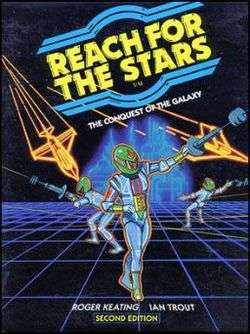Reach for the Stars (video game)
| Reach for the Stars | |
|---|---|
 Cover art | |
| Developer(s) | SSG |
| Publisher(s) | SSG |
| Platform(s) | MS-DOS, Apple II, Apple IIGS, Mac OS, Commodore 64, Amiga, Windows |
| Release date(s) | 1983 |
| Genre(s) | Turn-based strategy |
| Mode(s) | Single-player, Multiplayer |

Reach for the Stars is a science fiction strategy video game. It is the earliest known commercially published example of the 4X games (Explore, Expand, Exploit, Exterminate) genre. It was written by Roger Keating and Ian Trout of SSG of Australia and published in 1983 for the Commodore 64 and then the Apple II in 1985. Version 3 added a DOS port, though it did not share all of the features of the other platforms. The game was eventually ported to pre-Mac OS X versions of the Macintosh operating system, such as System 6. It was also ported to the Amiga and Apple IIGS, from the Mac OS version.
The player commands a home star in the galaxy, and then expands to form an interstellar empire by colonizing far-off worlds, building powerful starships, and researching new technologies.
Reach for the Stars was very strongly influenced by the board game Stellar Conquest. Many of RFTS's features have direct correspondence in Stellar Conquest.
Graphics are minimal, yet the tactical and strategic elements provide countless rich combinations for colony development and interstellar warfare. The software's AI also offered a challenging opponent in single-player games. It is not uncommon for a Reach for the Stars game to take over twelve hours to complete in single-player mode and 24 hours with multiple players.
Gameplay
In Versions 1 to 3 the player starts off with one planet that has Level 1 technology and a middle level environment. Three types of ships are available:
- Scouts - very inexpensive, incapable of fighting or carrying colonists. These can be used as a low-cost, low-risk means to learn the composition of unknown star systems or the locations and makeup of enemy fleets.
- Transports - incapable of fighting, but can carry colonists
- Warships - incapable of carrying colonists, but can fight
Starting players have limited funds, and have to decide where to invest the funds (technology upgrades, ships,or environmental upgrades). Upgrading a world's planetary environment, for example, means that its population grows more quickly, improving production; this is a mixed blessing, however, because if the population grows beyond the maximum allowed for that planet, the costs to feed the population skyrocket. Building a lot of ships early can win a player the game, if the player finds his enemies' home planets before they manage to upgrade their military technology; on the other hand, it can lead to a loss if the player's opponents upgrade first and attack with superior ships.
Each turn is divided into two sections - a development phase, and a movement phase. In the development phase, players work on planetary production, deciding what each planet will produce that turn. In the movement phase, players have the option to send ships to other star systems to explore, colonize, or conquer.
Because the game evolves along so many different axes of possibility, the game offers tremendous replay value. It is quite possible to save a game on the first turn, and have it play out differently each time it is restored.
Reception
Computer Gaming World in 1983 found Reach for the Stars quite user-friendly and enjoyable, with the single flaw of a lack of notification of natural disasters, which could not fit onto the disk space available. The computer AI and customization of each game were particular highlights of the review.[1] In a 1992 survey of science fiction games the magazine gave the title five of five stars, praising it as "Arguably the best science fiction game ever released ... a product still worth playing".[2] Compute! called the game "a particularly fine simulation of galactic exploration, combat, and conquest", noting that players needed to balance several different priorities to succeed. It concluded that Reach for the Stars was "one of the better games on the market this year".[3] inCider gave the Apple II version three stars, stating that while the game was "exciting", "[i]t's unromantic to say that much of the rest of the game is a matter of juggling numbers, but that's the truth".[4] The game was reviewed in 1994 in Dragon #211 by Jay & Dee in the "Eye of the Monitor" column. Jay did not rate the game, but Dee gave the game 3½ out of 5 stars.[5]
Sequel
A sequel to Reach for the Stars re-written for the Windows platform was released on September 14, 2000 by developer Strategic Studies Group and publisher Strategic Simulations, Inc. In 2005 Matrix Games working alongside Strategic Studies Group, updated the 2000 release; this updated version was released in 2005.[6]
References
- ↑ Curtis, Ed (December 1983). "Reach for the Stars". Computer Gaming World. pp. 27, 49.
- ↑ Brooks, M. Evan (November 1992). "Strategy & Wargames: The Future (2000-....)". Computer Gaming World. p. 99. Retrieved 4 July 2014.
- ↑ Trunzo, James V. (February 1986). "Reach for the Stars For Commodore And Apple". Compute!. p. 36. Retrieved 8 November 2013.
- ↑ Murphy, Brian J. (September 1986). "Game Room". inCider. pp. 113–114. Retrieved 2 July 2014.
- ↑ Jay & Dee (November 1994). "Eye of the Monitor". Dragon (211): 39–42.
- ↑ http://www.matrixgames.com/games/news.asp?gid=308
External links
- Reach for the Stars at MobyGames
- The MS-DOS version of Reach for the Stars can be played for free in the browser at the Internet Archive
- Gamespot review of Reach for the Stars 2000
- Matrix Games website